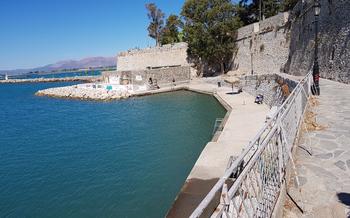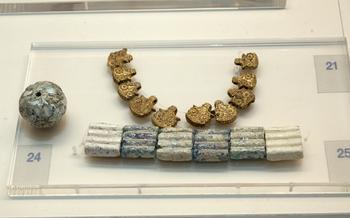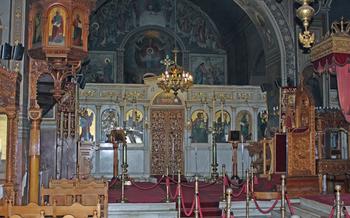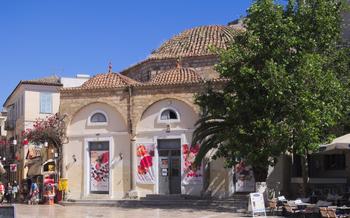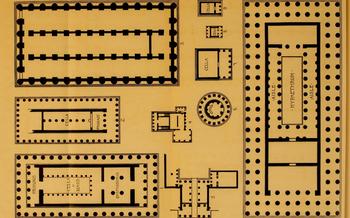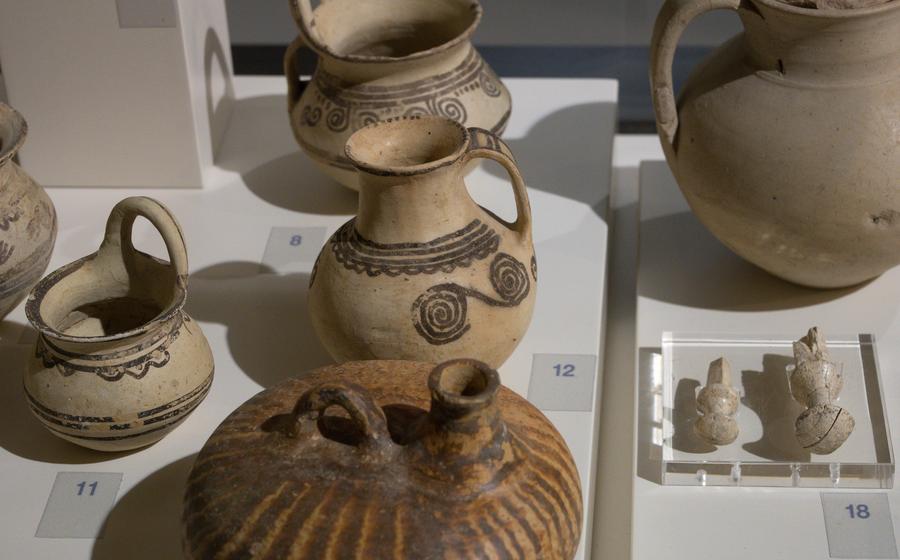
The Great Theatre of Epidaurus
- History of the Great Theatre of Epidaurus
- Location of the Theatre
- Architectural Design
- Acoustics of the Theatre
- Performances and Events
- Visiting the Theatre
- Nearby Attractions
- History of Epidaurus
- Epidaurus Festival
- Ancient Greek Theatre: A Legacy of Performance and Cultural Expression
- Restoration and Preservation
- Cultural Significance
- Acoustics and Science
- Accessibility for Visitors
- Insider Tip
History of the Great Theatre of Epidaurus
The Great Theatre of Epidaurus stands as a testament to the architectural prowess and cultural achievements of ancient Greece. Built in the 4th century BC, during the Hellenistic period, the theatre was designed by the renowned architect Polykleitos the Younger. He masterfully incorporated the principles of acoustics and aesthetics, creating a structure that would become renowned throughout the ancient world.
The theatre served as a venue for dramatic performances, particularly the tragedies and comedies of renowned playwrights such as Sophocles, Euripides, and Aristophanes. These plays explored themes of love, loss, heroism, and the human condition, captivating audiences and leaving a lasting impact on Western literature and theatre.
Location of the Theatre
The Great Theatre of Epidaurus is nestled within the picturesque Peloponnese region of Greece, approximately 2 hours by car from Athens. Its proximity to the enchanting town of Nafplio makes it an ideal day trip destination. Nafplio, with its Venetian charm and vibrant atmosphere, offers a delightful starting point for your journey to the theatre.
Reaching the theatre is a breeze, whether you choose to drive or take public transportation. By car, follow the scenic coastal road from Nafplio towards Epidaurus, enjoying the breathtaking views of the Argolic Gulf along the way. Alternatively, hop on a comfortable bus from Nafplio bus station, which will take you directly to the theatre's doorstep.
Once you arrive, you'll be greeted by a stunning landscape, with the theatre majestically situated against a backdrop of rolling hills and lush greenery. The surrounding area is dotted with olive groves, vineyards, and traditional Greek villages, inviting you to explore the region's rich cultural heritage and natural beauty.
Architectural Design
The Great Theatre of Epidaurus stands as a testament to the architectural genius of ancient Greece. Its awe-inspiring design and construction techniques have captivated architects and enthusiasts for centuries. The theatre's seating arrangements comprise 55 rows of limestone seats, each subtly curved to provide optimal comfort and acoustics. The rows are divided into 12 wedge-shaped sections by 34 staircases, ensuring easy access and a clear view of the stage for every spectator.
The stage and orchestra, the central performance areas, are equally impressive. The stage, or skene, is a long, narrow platform that served as a backdrop for the actors and chorus. It was adorned with elaborate painted panels and sculptures, adding depth and grandeur to the performances. The orchestra, a circular space in front of the stage, was used for the chorus to dance and sing. Its slightly sloped design allowed for better sound projection and visibility.
One of the most remarkable features of the theatre is its exceptional acoustics. The ancient Greeks, with their profound understanding of sound and physics, designed the theatre to amplify and project the actors' voices and music throughout the entire auditorium. This acoustic marvel is attributed to the theatre's specific shape, the materials used in its construction, and the precise placement of the seats and stage.
The theatre underwent extensive restoration efforts in the 20th century, led by renowned architect Ioannis Travlos. These efforts aimed to preserve the theatre's original form and function while adapting it to modern-day performances. The restoration involved meticulous cleaning and repairs, as well as the reconstruction of damaged sections. Today, the Great Theatre of Epidaurus stands as a beautifully preserved monument, ready to transport visitors back in time and showcase the brilliance of ancient Greek architecture and engineering.
Acoustics of the Theatre
The acoustics of the Great Theatre of Epidaurus are truly remarkable and have been the subject of much study and admiration. The theatre's design and construction are such that sound is projected and amplified with exceptional clarity and volume, even to the furthest seats. This is due to several factors, including the theatre's shape, the materials used in its construction, and the careful positioning of the stage and orchestra.
The theatre's horseshoe shape creates a natural amphitheater effect, focusing sound waves towards the center of the stage. The steep seating ensures that sound is reflected off the back rows and directed towards the audience, while the porous limestone used to build the theatre absorbs and diffuses sound, reducing echoes and reverberation.
The stage and orchestra are positioned in a way that maximizes sound projection. The stage is slightly elevated and projects forward, allowing sound waves to travel directly to the audience. The orchestra, located in front of the stage, serves as a resonant chamber, amplifying and reflecting sound waves.
Modern-day experiments and studies have confirmed the exceptional acoustics of the theatre. Sound engineers have measured sound levels at different points in the theatre and found that the sound intensity is relatively uniform throughout, with little variation between the front and back rows. This is a remarkable feat, considering that the theatre was built over 2,300 years ago without the use of modern sound amplification technology.
The unique acoustics of the Great Theatre of Epidaurus made it an ideal venue for ancient Greek dramas and performances. Actors could project their voices without strain, and the audience could hear every word and nuance, even from the back rows. This contributed to the immersive and emotional experience of attending a performance in the theatre.
Performances and Events
The Great Theatre of Epidaurus was not only a marvel of architecture but also a vibrant center for artistic expression. In ancient times, it hosted a variety of performances, primarily focused on Greek dramas and comedies. These plays tackled profound themes of love, loss, heroism, and the human condition, captivating audiences with their wit, eloquence, and emotional depth.
The theatre's acoustics played a crucial role in enhancing the performances. The carefully designed seating arrangements and the unique shape of the auditorium ensured that the actors' voices could be heard with remarkable clarity and resonance, even in the furthest seats. This allowed for a more immersive and engaging experience for the audience, drawing them into the stories unfolding on stage.
Today, the theatre continues to host performances, albeit with a more modern flavor. The annual Epidaurus Festival, held during the summer months, brings together renowned artists from around the world to showcase a diverse range of productions, including classical Greek dramas, contemporary plays, concerts, and dance performances.
Attending a performance at the Great Theatre of Epidaurus is a truly special experience. The combination of ancient history, exceptional acoustics, and breathtaking surroundings creates a magical atmosphere that transports visitors back in time. Whether you're a theatre enthusiast, a history buff, or simply seeking a unique and unforgettable experience, the Epidaurus Festival offers something for everyone.
Visiting the Theatre
To fully immerse yourself in the history and grandeur of the Great Theatre of Epidaurus, a visit is an absolute must. The theatre is open to the public daily, except for Mondays, from 8:00 AM to 3:00 PM. Admission fees are very reasonable, making it accessible to visitors of all budgets. Guided tours are available in multiple languages, providing an in-depth exploration of the theatre's history, architecture, and acoustics. Additionally, audio guides can be rented for a more self-guided experience.
To truly appreciate the theatre's acoustics, plan your visit for a time when there is no performance scheduled. This will allow you to experience the incredible sound quality without distractions. For an optimal experience, sit in the center of the theatre and speak in a normal voice to hear your words echoed back to you with remarkable clarity.
To make your visit even more memorable, consider packing a picnic lunch and enjoying it in the surrounding olive groves or by the nearby beach. The stunning views and tranquil atmosphere will enhance your overall experience.
Nearby Attractions
The Great Theatre of Epidaurus is not an isolated monument but is part of a wider historical and archaeological context that includes several nearby attractions that are worth exploring.
Just a short walk from the theatre lies the Ancient Epidaurus site, a sprawling complex of ruins that includes the remains of a temple, a stadium, and other public buildings. Visitors can wander through the ruins, admire the well-preserved mosaics, and get a sense of the scale and grandeur of the ancient city.
Another nearby attraction is the Asklepieion of Epidaurus, a sanctuary dedicated to the Greek god of healing, Asclepius. The Asklepieion was once a major center of healing in the ancient world, and visitors can still see the remains of the temples, hospitals, and other buildings where patients sought treatment.
The Museum of Epidaurus houses a collection of artifacts from the ancient city, including sculptures, pottery, and medical instruments. The museum provides visitors with a deeper understanding of the history and culture of Epidaurus.
In addition to these historical and archaeological attractions, the area around Epidaurus is also home to several beautiful beaches and coastal towns. Visitors can relax on the sandy beaches, swim in the crystal-clear waters, and explore the charming towns that dot the coastline.
History of Epidaurus
Epidaurus, located in the Peloponnese region of Greece, has a rich and captivating history. In ancient times, it was renowned as a prominent healing center, attracting individuals seeking relief from various ailments. The sanctuary of Asclepius, the Greek god of medicine, was the focal point of Epidaurus' healing reputation. Devotees would come to the sanctuary to seek divine intervention and partake in rituals and treatments prescribed by the priests of Asclepius.
Archaeological excavations at the site have unearthed an extensive complex of structures, including a temple dedicated to Asclepius, a theatre, a stadium, and a gymnasium. These remains provide valuable insights into the practices and beliefs of ancient Greek medicine. The Asklepieion of Epidaurus, as it is known, is considered one of the most significant healing centers in the ancient world.
Epidaurus also holds mythological connections. According to Greek mythology, the hero Asclepius was born in Epidaurus, and his mother, Coronis, was a daughter of King Phlegyas of Orchomenus. Asclepius' reputation as a healer grew, and he became known for his ability to bring people back from the dead. This angered Hades, the god of the underworld, who convinced Zeus to strike Asclepius with a thunderbolt. Asclepius' death led to the establishment of his sanctuary in Epidaurus, where people could seek healing and pay homage to the divine physician.
Epidaurus Festival
The annual Epidaurus Festival is a prestigious summer event that takes place in the ancient theatre, showcasing a variety of performances that pay homage to the rich cultural heritage of Greece. The festival features an impressive lineup of renowned Greek and international artists, presenting a diverse range of ancient Greek dramas, comedies, concerts, and dance performances. The festival atmosphere is electric, with visitors from around the world gathering to experience the magic of ancient Greek theatre under the stars. In addition to the performances, the festival offers a variety of cultural events, workshops, and exhibitions, providing a holistic immersion into the world of ancient Greek culture and history. The Epidaurus Festival is a must-attend event for theatre enthusiasts, history buffs, and anyone seeking an unforgettable cultural experience.
Ancient Greek Theatre: A Legacy of Performance and Cultural Expression
The Great Theatre of Epidaurus stands as a testament to the rich theatrical tradition of ancient Greece. Theatre, a cornerstone of Greek culture, served as a platform for storytelling, entertainment, and social commentary. It played a vital role in shaping public opinion, addressing political issues, and exploring philosophical and moral dilemmas.
The origins of ancient Greek theatre can be traced back to religious festivals and rituals, where performances centered around myths and legends. Over time, theatre evolved into a more sophisticated form, with the emergence of playwrights such as Sophocles, Euripides, and Aristophanes. These playwrights crafted powerful dramas and comedies that explored human nature, societal norms, and the complexities of the human condition.
Ancient Greek theatres were typically built on hillsides, utilizing the natural acoustics to amplify the voices of the actors. The stages were relatively simple, with a raised platform for the actors and a chorus performing in front of a painted backdrop. The audience sat in semicircular rows of stone or wooden seats, providing an intimate and immersive experience.
The ancient Greek theatre was a place of cultural exchange and intellectual discourse. It brought together people from different backgrounds and social classes, fostering a sense of community and shared identity. It also played a significant role in educating and informing the public, addressing issues of justice, equality, and the human experience.
The legacy of ancient Greek theatre continues to influence modern theatre and performance practices around the world. Its emphasis on storytelling, character development, and the exploration of universal themes has shaped the way we think about theatre and its role in society. The Great Theatre of Epidaurus, as a living example of this rich tradition, offers a glimpse into the origins of Western theatre and the enduring power of live performance.
Restoration and Preservation
The Great Theatre of Epidaurus has undergone extensive restoration and preservation efforts to maintain its structural integrity and historical authenticity. Collaborations with international organizations such as UNESCO have ensured that the theatre's unique features are preserved while implementing sustainable tourism practices.
The restoration process involved meticulous cleaning and repair of the theatre's stonework, including the seating areas, stage, and orchestra. Efforts were made to retain the original materials and techniques used in the ancient construction, ensuring the theatre's authenticity.
The surrounding area of the theatre has also been carefully landscaped to enhance the visitor experience and protect the site's natural beauty. Pathways and signage have been designed to guide visitors while minimizing impact on the environment.
By balancing preservation and accessibility, the restoration efforts have ensured that the Great Theatre of Epidaurus continues to captivate audiences and serve as a symbol of ancient Greek culture for generations to come.
Cultural Significance
The Great Theatre of Epidaurus stands as a testament to the enduring legacy of ancient Greek culture. Designated as a UNESCO World Heritage Site, it is recognized for its exceptional cultural and historical value. The theatre embodies the architectural prowess and artistic achievements of the ancient Greeks, serving as a symbol of their theatrical traditions and contributions to the performing arts. Its remarkable acoustics, architectural design, and historical significance continue to inspire and captivate audiences to this day.
The theatre's enduring cultural significance extends beyond its physical structure. It represents a crucial aspect of ancient Greek society, where theatre played a central role in religious rituals, civic life, and entertainment. The performances held in the theatre reflected the cultural, social, and political values of the time, addressing themes of mythology, morality, and human nature. The theatre's legacy has profoundly influenced the development of modern theatre and architecture worldwide, shaping the way we experience and appreciate the performing arts.
Acoustics and Science
The exceptional acoustics of the Great Theatre of Epidaurus have fascinated scholars and scientists for centuries. The theatre's design and construction techniques create a unique auditory experience, allowing sound to project clearly and evenly throughout the entire seating area.
The theatre's bowl-shaped design, with its carefully calculated angles and curves, acts as a natural amplifier. The materials used in its construction, such as limestone and marble, also contribute to the excellent acoustics. These materials absorb and reflect sound in a way that enhances clarity and minimizes reverberation.
Modern-day experiments and studies have confirmed the remarkable acoustic properties of the theatre. Researchers have used advanced sound measurement techniques to map the sound distribution within the theatre and have found that even a whisper from the stage can be heard clearly in the back rows.
The acoustics of the Great Theatre of Epidaurus continue to be a source of inspiration for architects and acousticians around the world. The principles behind its design have been applied to modern concert halls, stadiums, and other performance spaces, ensuring that audiences can enjoy the same clarity and richness of sound that ancient Greek audiences experienced over two thousand years ago.
Accessibility for Visitors
The Great Theatre of Epidaurus is committed to ensuring accessibility for all visitors, regardless of their abilities. The theatre and its surrounding areas are wheelchair accessible, with ramps and designated seating areas for visitors with disabilities. Audio guides and guided tours are available in multiple languages, including sign language interpretation upon request. Visitors can also request assistance from the friendly and knowledgeable staff, who are always ready to provide information and directions.
To ensure a smooth and enjoyable visit, it is advisable to contact the theatre in advance if you have any specific accessibility requirements. The staff will be happy to assist you in planning your visit and making any necessary arrangements. The theatre also offers a variety of educational programs and workshops designed to be inclusive and accessible to all visitors.
By prioritizing accessibility, the Great Theatre of Epidaurus strives to create a welcoming and inclusive environment where everyone can experience the wonder and magic of this ancient masterpiece.
Insider Tip
To make your visit to the Great Theatre of Epidaurus truly unforgettable, consider exploring these insider tips:
-
Sunset Magic: Plan your visit to coincide with the sunset for a truly enchanting experience. As the sun dips below the horizon, casting a warm golden glow over the ancient theatre, the atmosphere becomes magical and ethereal.
-
Picnic Perfection: Pack a delightful picnic and find a spot within the theatre to enjoy a leisurely meal while soaking in the breathtaking views. Imagine savoring delicious local delicacies amidst the ancient ruins, creating memories that will last a lifetime.
-
Epidaurus Festival Splendor: If your travel plans align, don't miss the opportunity to attend a performance during the annual Epidaurus Festival. This prestigious event showcases a lineup of renowned artists and captivating shows, offering a unique chance to experience ancient Greek dramas and modern-day performances in their original setting. Immerse yourself in the vibrant festival atmosphere and let the spirit of the theatre transport you back in time.
